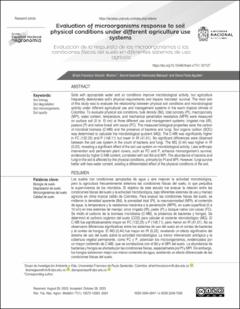Evaluation of microorganisms response to soil physical conditions under different agriculture use systems
Evaluación de la respuesta de los microorganismos a las condiciones físicas del suelo en diferentes sistemas de uso agrícola
Artículo de revista
2024-01-01
Revista Facultad Nacional de Agronomia Medellin
Medellín,Colombia
Soils with appropriate water and air conditions improve microbiological activity, but agriculture frequently deteriorates soil’s physical requirements and impairs microbes’ survival. The main aim of this study was to evaluate the relationship between physical soil conditions and microbiological activity under different agricultural use and management systems in the warm tropical climate of Colombia. To evaluate physical soil conditions, bulk density (Bd), total porosity (Pt), macroporosity (MPt), water content, temperature, and mechanical penetration resistance (MPR) were measured on surface soil (0 to 10 cm) at three different use and management systems: irrigated rice (IR), pasture (P) and native forest with cacao (FC). The measured biological properties were the carbon of microbial biomass (C-MB) and the presence of bacteria and fungi. Soil organic carbon (SOC) was determined to calculate the microbiological quotient (MQ). The C-MB was significantly higher in FC (132.25) and P (148.11) but lower in IR (41.61). No significant differences were observed between the soil use system in the count of bacteria and fungi. The MQ (0.44) was higher in IR (0.22), revealing a significant effect of the soil use system on microbiological activity. Less anthropic intervention and permanent plant covers, such as FC and P, enhance microorganism’s survival, evidenced by higher C-MB content, correlated with soil Bd and MPt. The abundance of bacteria and fungi in the soil is affected by the physical conditions, primarily by Pt and MPt. However, fungi survive better with less water content, existing a differentiated effect of the physical conditions of the soil. Los suelos con condiciones apropiadas de agua y aire mejoran la actividad microbiológica, pero la agricultura frecuentemente deteriora las condiciones físicas del suelo, lo que perjudica la supervivencia de los microbios. El objetivo de este estudio fue evaluar la relación entre las condiciones físicas del suelo y la actividad microbiológica, bajo diferentes sistemas de uso y manejo agrícola en clima tropical cálido de Colombia. Para evaluar las condiciones físicas del suelo, se midieron la densidad aparente (Bd), la porosidad total (Pt), la macroporosidad (MPt), el contenido de agua, la temperatura y la resistencia mecánica a la penetración (MPR), en suelo superficial (0 a 10 cm) en tres sistemas de manejo: arroz irrigado (IR), pasto (P) y bosque nativo con cacao (FC). Se midió el carbono de la biomasa microbiana (C-MB), la presencia de bacterias y hongos. Se determinó el carbono orgánico del suelo (COS) para calcular el cociente microbiológico (MQ). El C-MB fue significativamente mayor en FC (132,25) y P (148,11), pero menor en IR (41,61). No se observaron diferencias significativas entre los sistemas de uso del suelo en el conteo de bacterias y el conteo de hongos. El MQ (0,44) fue mayor en IR (0,22), revelando un efecto significativo del sistema de uso del suelo sobre la actividad microbiológica. La menor intervención antrópica y la cobertura vegetal permanente, como FC y P, potencian los microorganismos, evidenciados por un mayor contenido de C-MB, que se correlaciona con el Bd y el MPt del suelo. La abundancia de bacterias y hongos es afectada por las condiciones físicas, especialmente por Pt y MPt. Sin embargo, los hongos sobreviven mejor con menor contenido de agua, existiendo un efecto diferenciado de las condiciones físicas del suelo.
- Ambiente y Vida - GIAV [131]
Descripción:
COMPAG.+(5)+-+RFNA+107127.pdf
Título: COMPAG.+(5)+-+RFNA+107127.pdf
Tamaño: 495.5Kb
 PDF
PDF
 LEER EN FLIP
LEER EN FLIP
Título: COMPAG.+(5)+-+RFNA+107127.pdf
Tamaño: 495.5Kb
 PDF
PDF
 LEER EN FLIP
LEER EN FLIP

















